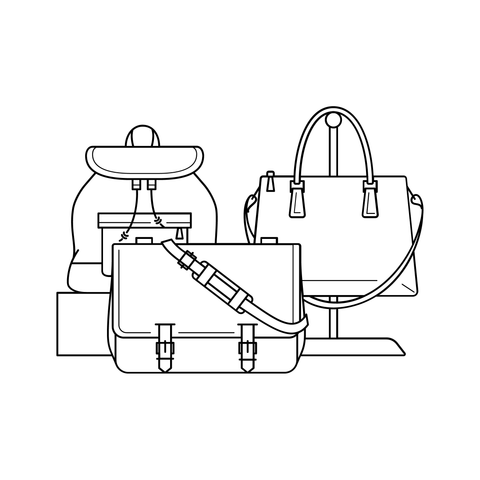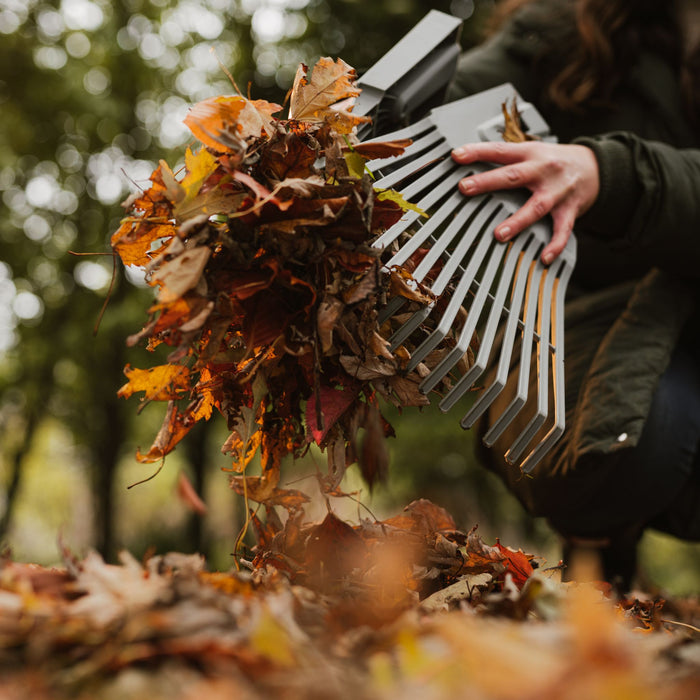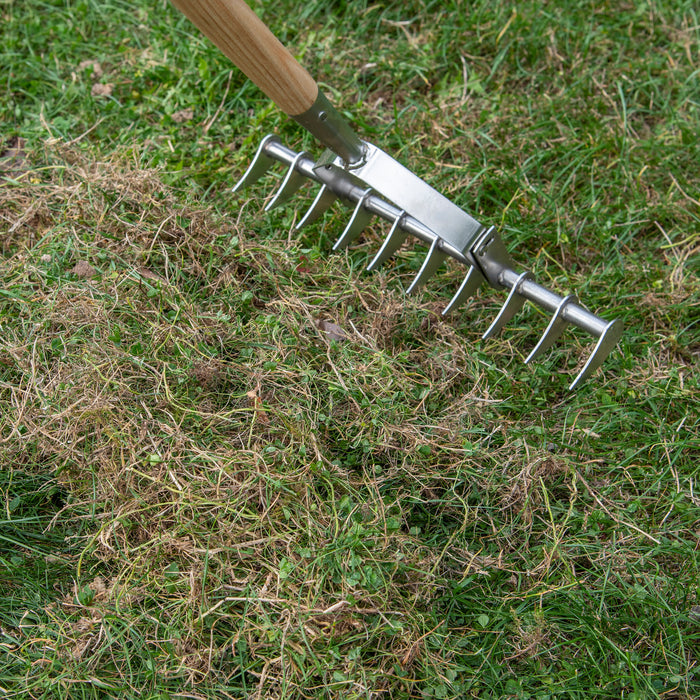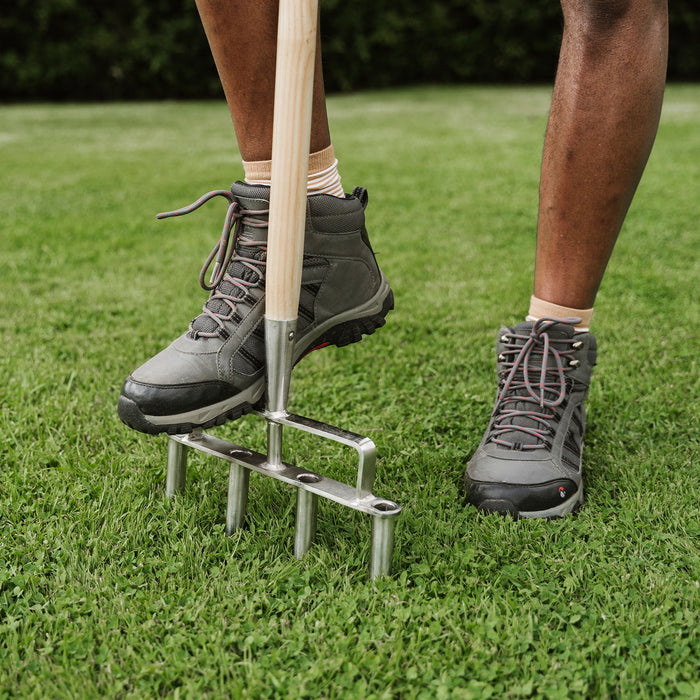After a busy summer of barbecues, garden games, and warm weather, your lawn might be looking a little tired. Heavy use, heat, and lack of rain can all leave the grass dry, thin, compacted or patchy.
Autumn is the ideal time to repair this damage and give your lawn the care it needs to recover. With the soil still warm, days cooling, and more moisture in the air, conditions are perfect for grass to regrow. By spending just a little time now, you can set your lawn up to survive the winter and thrive again next spring.
Best Months for Lawn Renovation
September and October are ideal for lawn renovation. With comfortably lower temperatures and warm, moist, and workable soil, you can achieve great results. Here are our top lawn jobs for the autumn months and how you can put your Kent & Stowe tools to good use.
Clear Away Leaves and Debris
As autumn arrives, falling leaves quickly build up on the lawn. If left, this layer of damp material blocks out light and air, weakening the grass underneath and creating the perfect environment for moss to spread. Damp, rotting leaves create an ideal environment for lawn moss to thrive, while a blanket of leaves on paths, patios and driveways can form a slip hazard. Pushing lawnmowers over excessive debris risks damaging blades and mowers can get clogged with wet debris, so make sure you’re armed with the right tools.
Using a leaf rake is the simplest, most cost-effective way to remove leaves from your lawn. If conditions are breezy, rake lawns in the direction the wind is blowing – it’ll make the job easier. A Kent & Stowe 3 in 1 Rake is perfect to use for clearing and collecting leaves from different areas of the garden. The extra wide head makes for effortless clearing of large areas such as lawns, while the detachable heads transform the rake into a slimline version, allowing leaves to be pulled from tight spaces around plants and under shrubs. Detachable grabbers allow gardeners to quickly pick up gathered leaves and deposit them in a wheelbarrow or add them to the compost heap.
Scarify to Remove Moss and Thatch
If you only have time for one task, make it scarifying. Thatch is the layer of dead grass, moss, and organic matter that builds up on the soil’s surface. Over time, this layer can prevent water, air, and nutrients from reaching the roots, leaving your lawn looking dull and unhealthy. Scarifying in autumn removes this build-up and allows new growth to come through.
A Scarifying Rake is ideal for the job as its sharp, angled tines cut through the turf to lift out moss and thatch effectively. It might leave your lawn looking a bit rough at first, but this is normal and creates space for stronger, healthier grass to grow.

Aerate to Relieve Compaction
Lawns often become compacted after a summer of heavy foot traffic. Compacted soil prevents roots from growing deeply and stops rainwater from draining away, which can lead to surface waterlogging over winter. Aerating the lawn relieves this compaction by creating small holes that let air, water, and nutrients flow down to the roots.
You can use a garden fork or a Lawn Aerator to spike the soil evenly across the lawn to extract soil plugs. Aerating now helps roots grow deeper and makes your lawn stronger and more drought-resistant in the future. After aerating, apply a top dressing of sand, loam, and well-rotted organic matter to the holes to revitalize the lawn. Aerate every two or three years.

Cut back Trees
A lawn doesn’t need to bask in sunshine all day to thrive, but grass does need good light and water to remain healthy, green, and lush. Where grass is subjected to dry shade, lawns can display a yellow tinge, due to weak, malnourished grass that’s susceptible to disease, wear and tear.
If too much shade is taking its toll on your lawn, cutting back overhanging trees and shrubs can allow much-needed light and rainwater to replenish the grass below. Use sharp, telescopic loppers like SureCut to enable you to reach high branches.
Dealing with overhanging canopies also reduces twigs and debris falling onto lawns during stormy weather, risking potential damage to your lawnmower if the spinning blades are struck by the debris.
Essential Autumn Feeding
If you’re not reseeding this autumn, applying a seasonal lawn feed is a great way to strengthen your existing grass. Autumn lawn feeds are specially formulated with a lower nitrogen content to reduce soft growth, and a higher level of potassium to toughen grass against frost, disease, and wear over winter. Feeding at this time of year encourages strong roots and keeps your lawn greener for longer into the colder months. Always follow the product instructions carefully and apply in calm, dry weather for the best results.

Overseeding and Patch Repair
After scarifying and aerating, overseed your lawn to thicken sparse, patchy turf. Sow seed evenly and keep it well-watered in dry conditions. Gro-Sure Smart Lawn Seed Fast Start is a good option as the seed germinates in colder temperatures. For small patches or areas damaged by dog urine, use patch repair kits like Aftercut Patch Fix, which contain grass seed and feed. Remove dead grass, break up the soil, add the patch mix, and keep the area well-watered.

Sowing a New Lawn
Early autumn is the best time to sow a new lawn from seed, as it germinates quickly in warm, moist soil and establishes roots before winter. Prepare the ground by digging it over, removing weeds and stones, treading it down, and raking it level. Sow grass seed evenly at about 20 to 25g per square meter, lightly rake the soil over the seeds, and keep new lawns watered if rain is sparse. Avoid walking on newly sown lawns for the first month until the grass is established.

With just a little care this autumn, you can restore your lawn after summer stress and give it the best possible start for the year ahead. From raking leaves and scarifying, to aerating, overseeding, and feeding, each step helps your lawn grow thicker, stronger, and healthier.










